Measuring in at 6.7″ x 6.7″, MSI's Z87I Gaming AC conforms to the typical mITX form factor. As a Gaming Series product, the Z87I Gaming AC uses a red and black colour scheme. Given the board's smaller dimensions, the dark shade of red is limited to accents on heatsinks.
Knowing that style is key on a modern gaming product, irrelevant of its form factor, MSI builds the Z87I Gaming AC around a matte black PCB. Users who enjoy showing off their system are likely to be impressed by the Z87I Gaming AC motherboard's overall appearance.
A pair of controllers is found on the motherboard's rear side, one of which is a Nuvoton NCT6779D, as well as spring-loaded screws which hold the heatsink in place.
Up to 16GB of DDR3 memory can be installed in the two single-latch DIMM slots. As is the case with its other Z87-based Gaming Series motherboards, MSI claims support for up to 3GHz memory speeds. Of course, the real-world maximum frequency will also be related to the strength of a CPU’s IMC.
Spacing between the DIMM banks and CPU socket was sufficient to eliminate interference between the pump unit and exiting hoses of our Corsair H100i CPU cooler. Larger, dual-tower air coolers are likely to cause interference problems with tall RAM heatspreaders.
MSI uses a six phase power delivery system to feed an LGA 1150 CPU. Given the board's intended usage, the six phase system should be sufficient for the type of overclocks that SFF users are likely to apply. Thermal stability of a Haswell chip will become an issue before the motherboard's power delivery system does.
Unlike many lower-priced Military Class 4 motherboards, the Z87I Gaming AC does use MSI’s full complement of power delivery components. Super Ferrite Chokes (SFC), Hi-c CAPs, and aluminium-core ‘Dark’ capacitors all make an appearance. The components are implemented with efficiency, stability, and longevity at the forefront of their design.
Tucked beside the dragon-shaped MOSFET heatsink is the 8-pin CPU power connector. Its location makes it a little tricky to disconnect due to the surrounding space constraints, but it also keeps the thick cable away from the valuable SATA ports.
A mini-PCIe card sporting the Intel 7260 chipset provides dual band, two stream 802.11ac Wi-Fi. The chipset can reach a theoretical speed of 867Mbps and is able to operate on both the 5GHz and 2.4GHz frequency bands. Bluetooth 4.0 is also provided by the chipset.
It is actually quite surprising to see MSI opting for an Intel chipset rather than the popular Broadcom alternative that many of its competitors use. One clear benefit of the Intel chipset is its support for Intel's Wireless Display (WiDi), although the technology's relevance is up for debate.
Only two fan headers are found on the entire motherboard, both of which are 4-pin outputs situated between the WiFi card and chipset heatsink. One of the headers is connected to the CPU fan lane, while the other is given system fan duties.
We would have liked to see MSI provide at least one more fan header; one CPU fan and another for case duties is particularly scarce, even by mITX standards.
A miniature heatsink embossed with the dragon logo cools the Z87 chipset.
Positioned along the Z87I Gaming AC's upper edge are the 24-pin power connector, internal USB 3.0 header, and five SATA 6Gbps ports.
Both of the storage interfaces operate natively from the Z87 chipset, while the remaining SATA port is implemented as a rear IO eSATA connection.
One notable omission is an mSATA connection which is becoming increasingly popular across space-constrained motherboards. It is clear that MSI had little room spare to place an mSATA connection on the board's front side, but it could have deployed one on the board's rear.
Whether or not users will miss the mSATA connection is related to the specific person's requirements, but adding in its functionality (and maintaining the five internal SATA connections by sharing a lane) may have been welcomed by a proportion of the target audience.
A cluster of headers located between the SATA ports and 8-pin CPU power connection serve USB 2.0 and front panel duties.
Quite frankly, attaching front panel cables to the Z87I Gaming AC is a nightmare. MSI does not include its M-connector block in a scenario where it would provide its greatest support, nor does the company print the name of each front panel header on the board's PCB.
We were forced to determine the relevant headers via the motherboard's manual while working carefully in a tight space to ensure that each connection was attached correctly. The M-connector block would have allowed the tricky procedure to be completed outside the constrained environment of a mITX chassis before being attached to the motherboard with ease.
A single PCI-E 3.0 x16 connection allows users to install a modern graphics card in their Z87I Gaming AC-based system. MSI gives the slot clear access so that large graphics cards can pass the motherboard's edge without interference.
MSI equips the Z87I Gaming AC with its Audio Boost sound system which somewhat eliminates the requirement for a gamer to purchase an add-on sound card. It's moves like these which help to make mITX components viable solutions for gamers and enthusiasts who do not want to sacrifice any part of the immersive experience.
Audio Boost consists of a Realtek ALC1150 audio codec which sends the raw signal through a Texas Instruments OPA1652 operational amplifier and a series of audio capacitors before outputting it to the audio jacks. The process takes place on an isolated circuit and outputs the signal to gold-plated audio jacks, with both measures helping to reduce signal interference.
Sound Blaster Cinema is also supported by the Z87I Gaming AC.
And if you're a gamer who uses a USB headset, MSI suggests that its USB Audio Power helps to deliver a higher quality signal to the USB DAC. The array of electrical components situated above the PCI-E slot work to ensure that voltages fed to the rear USB 3.0 ports are maintained at optimum levels.
The Z87I Gaming AC's healthy rear IO panel includes four USB 3.0 ports, an eSATA connection, and the ever-convenient clear CMOS button. The Gigabit Ethernet port is fed by a Killer E2205 NIC to provide reduced-lag gaming.
Gold-plated audio jacks reduce the amount of interference that is inserted into a sound output signal, while an optical SPDIF jack serves media purposes.
Up to three displays can be powered simultaneously via the DVI-I (which can be converted to VGA), HDMI, and DisplayPort connections. The DisplayPort connection is able to output high-resolution (2560 x 1600) signals, while the HDMI and DVI connections are limited to 1920 x 1200, according to MSI.
With all of this said, it is highly likely that a user of the Z87I Gaming AC will also be making use of a discrete graphics card.
Both of the adjustable antennae are screwed into gold-plated connectors to provide a clean signal.
Motherboard rear ports:
- 1 x PS/2 keyboard/mouse combo port
- 1 x Clear CMOS button
- 2 x USB 2.0 ports
- 4 x USB 3.0 ports
- 1 x Optical S/PDIF OUT connector
- 1 x RJ45 LAN jack
- 2 x Antennae connectors
- 1 x eSATA port
- 6 x OFC audio jacks
- 1 x DVI-I port
- 1 x HDMI port
- 1 x DisplayPort
Continuing its Gaming Series trend, MSI employs an attractive dragon-shaped heatsink on the Z87I Gaming AC.
 KitGuru KitGuru.net – Tech News | Hardware News | Hardware Reviews | IOS | Mobile | Gaming | Graphics Cards
KitGuru KitGuru.net – Tech News | Hardware News | Hardware Reviews | IOS | Mobile | Gaming | Graphics Cards


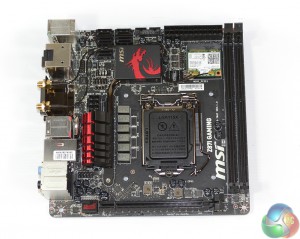
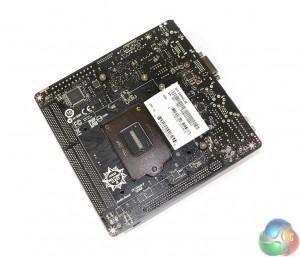
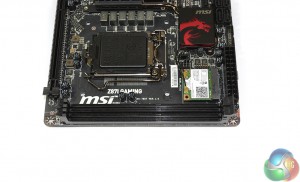
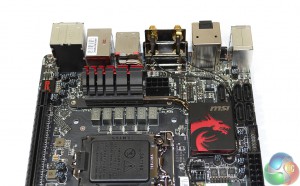
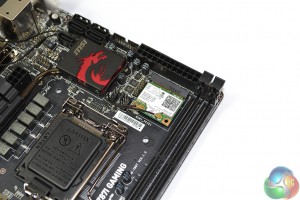
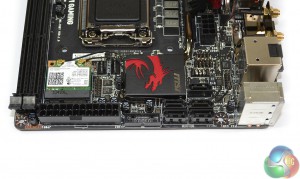
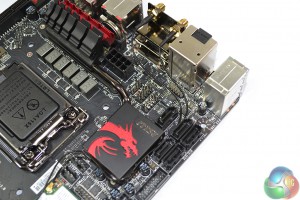
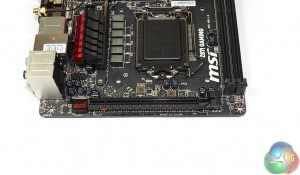
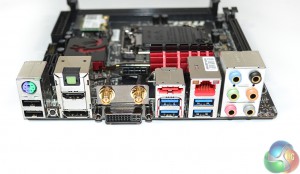
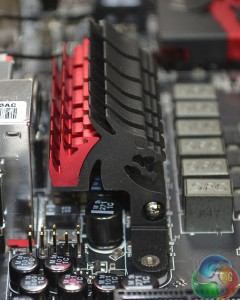
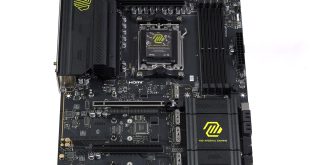
Awesome board, love MSI products – building a media center soon and this was already on my shortlist. unless something comes out soon which is better.
This is my dream in 2014 – build a silent, small system which can play games at 1080p and not break the bank. Still working on it !
Little Giant! Brilliant design, small but fully loaded.
I just hope I could win that kind of awesome motherboard 😀
Great performing board, great looks and very stable.
Using it in a corsair 250D case atm.
Motherboard layout can give some problems with cablemanagement tho when u want everything neat and clean. Thats something that could be improved next time.
Having only 1 chafan conn is simply absurd.